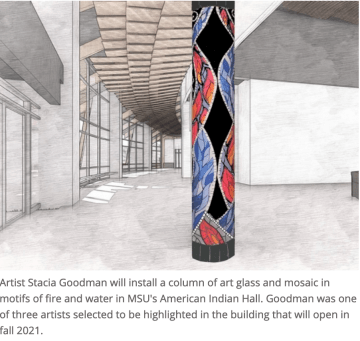Three artists selected to display work in MSU’s American Indian Hall
Sunday Sep. 13th, 2020
Three artists have been selected to display major pieces of their work in Montana State University’s American Indian Hall, which is slated to be completed next fall.
Artists Bently Spang, a member of the Northern Cheyenne Tribe who lives in Billings, Robert Martinez, a Northern Arapaho who lives in Riverton, Wyoming, and Stacia Goodman of Minneapolis were selected by a committee of eight members. The committee was composed of representatives from across MSU’s campus as well as members from Montana’s Native community.
Walter Fleming, chair of the Department of Native American Studies, said the committee distributed a call for artists for the building, which will open next year. Twenty-six artists responded to a request for proposals with projects that would represent the university’s desire to make the American Indian Hall reflective of Native culture as well as the building’s major themes of water, fire, earth and air.
“The major themes reflect the natural elements that many indigenous cultures revere,” Fleming said. He said each one of the artists are significant in their potential to engage visitors to the American Indian Hall and to generate deeper thought.
The 31,000-square-foot American Indian Hall will serve as a home to MSU’s Native American community as well as a bridge between American Indian culture and other cultures on campus. The building is planned to open in fall 2021, and classes will be held there beginning spring semester 2022.
Spang is a Northern Cheyenne multidisciplinary artist, writer and curator whose art utilizes technology to tell timeless visual stories. His work has been exhibited in North America, South America and Europe. Spang’s proposal is to install a bank of video monitors onto a frame that will be built in the shape of a large Plains Indian war shirt. The screens will display synchronized videos that will include scenes of fire and water as well as highlights of the tribal communities in the region.
“(Spang’s) art will give the hall the ability to create new subject matter for the screens that will make his art timely,” Fleming said.
Martinez is a visual artist and designer who will use paintings in vibrant and contrasting colors that transform the standard photo studio style sepia portraits into vivid images.

“We want his paintings to reflect the whimsy and humor of Native culture and represent our students as hard-working and fun-loving,” Fleming said. “We want our students to be able to see themselves in his portraits.
Goodman is a non-Native artist who creates mosaic pieces of art glass and tile. Her work will cover a column in the AIH project.
“What is exciting about Ms. Goodman’s concept is that, as a column, visitors will be able to walk around it, providing art that visitors can engage in close-up,” Fleming said. “(Her) mosaic style gives her pieces the quality of movement, perfect for water and fire.

Fleming said that in addition to the featured artists, members of the community have been generous in donating art from their homes for potential use in the American Indian Hall.
“This has been particularly gratifying as we will have a lot of wall space in our new home,” he said.
Major Robinson, the cultural design liaison for the project who is also a member of the selection committee, said that public art is important for most buildings, but particularly the American Indian Hall, which he calls an “environmentally respectful building.”

“These art pieces represent and communicate values tribal peoples bring to the campus for the time MSU is their home,” said Robinson, a Northern Cheyenne architectural designer who has also served as a member of the Montana Board of Regents and is the owner and principal of Redstone Project Development.
“Besides creating a sense of home, these very same indigenous expressions of art welcome non-Native students and visitors to learn more about the original pre-Montana inhabitants' culture and values.”
Robinson said that he believes the entire building will be a living piece of art, from the Native plants outside the building that will greet visitors, the eagle feather canopy to the culturally infused drum room that will be crafted from 100-year-old “grandfather spruce, thoughtfully harvested and preserved on site to make room for the new American Indian Hall.”
“Each space one passes through is an invitation for all who enter to discover more about tribal peoples and hopefully realize the value they add to Montana State University,” Robinson said.
Swank Enterprises is the general contractor on the project, and the architect is ThinkOne Architecture.
| Tweet |